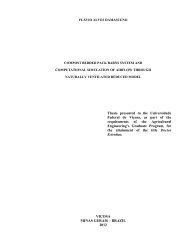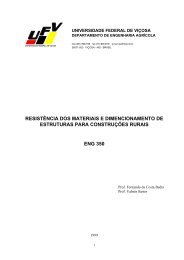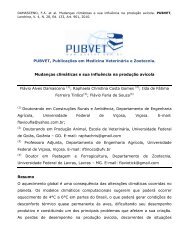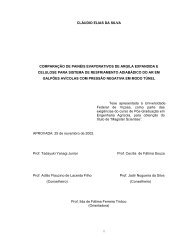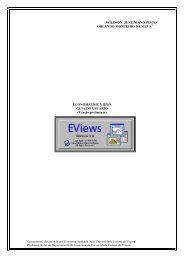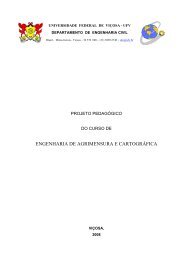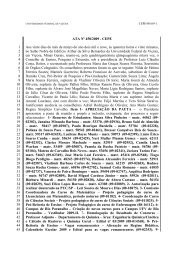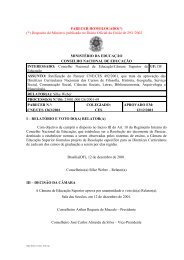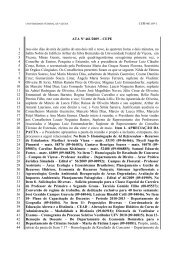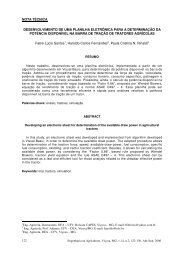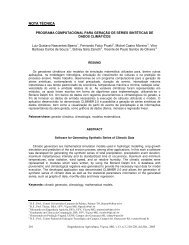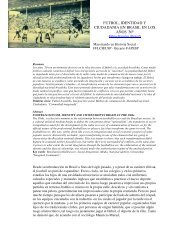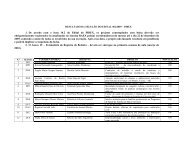ALKALOID BIOSYNTHESIS IN PLANTS: Biochemistry, Cell ... - UFV
ALKALOID BIOSYNTHESIS IN PLANTS: Biochemistry, Cell ... - UFV
ALKALOID BIOSYNTHESIS IN PLANTS: Biochemistry, Cell ... - UFV
Create successful ePaper yourself
Turn your PDF publications into a flip-book with our unique Google optimized e-Paper software.
38 FACCH<strong>IN</strong>I<br />
subsequent methyltransferase reactions, it was originally thought that the tetrahydroxybenzylisoquinoline<br />
alkaloid (S)-norlaudanosoline was the precursor to BIAs<br />
(141). However, only norcoclaurine has been found to occur in plants.<br />
(S)-Norcoclaurine is converted to (S)-reticuline by a 6-O-methyltransferase (49,<br />
147), an N-methyltransferase (47), a P450 hydroxylase (133), and a 4 ′ -O-methyltransferase<br />
(48, 147). The SAM-dependent 6-O- and 4 ′ -O-methyltransferases<br />
(6OMT and 4 ′ OMT, respectively) have been purified from cultured Coptis japonica<br />
cells (147), and the corresponding cDNAs isolated and characterized (114).<br />
Although the two enzymes display similar enzymological properties, they exhibit<br />
distinct substrate specificities. Moreover, the 6OMT follows a “ping-pong bi bi”<br />
mechanism, whereas the 4 ′ OMT catalyzes an “ordered bi bi” reaction (114). Four<br />
homologous O-methyltransferase cDNAs (OMT II;1-4) have also been isolated<br />
from MeJA-treated Thalictrum tuberosum cell cultures (49). Heterologous expression<br />
of the OMT II;1-4 cDNAs showed that homodimers and various heterdimeric<br />
combinations of the four isoforms exhibit broad substrate specificity.<br />
The O-methylated substrates included simple catechols, phenylpropanoids, and<br />
various BIAs, suggesting that some of the isoforms are involved in both BIA<br />
and phenylpropanoid metabolism. For example, the homodimer of OMT II;1 efficiently<br />
O-methylates (R,S)-norcoclaurine (Figure 2) and various catechol and<br />
caffeic acid derivatives. Remarkably, OMT II;4 differs from OMT II;1 by only<br />
one amino acid, but its homodimer does not catalyze the alkaloid methylations.<br />
Both the 6OMT and 4 ′ OMT from C. japonica show relatively low identity (24 and<br />
35%, respectively) to the various catechol OMT II isoforms (114). The in vivo<br />
contribution, if any, of the OMT II enzymes to BIA biosynthesis remains to be<br />
established.<br />
Originally, the aromatic-ring hydroxylation involved in the conversion of (S)norcoclaurine<br />
to (S)-reticuline was thought to be catalyzed by a nonspecific phenol<br />
oxidase (89). However, a P450-dependent monooxygenase (CYP80B1; Figure 2)<br />
isolated from Eschscholzia californica (133) and opium poppy (72, 182) exhibits<br />
a K m for (S)-N-methylcoclaurine 39-fold lower than that of the phenolase; thus,<br />
CYP80B1 is now known to convert (S)-N-methylcoclaurine to (S)-3 ′ -hydroxy-Nmethylcoclaurine.<br />
CYP80B1 is encoded by two to three genes in E. californica<br />
(133) and opium poppy (72, 182).<br />
Intermediates of the (S)-reticuline pathway also serve as the precursors<br />
to ∼270 dimeric bisbenzylisoquinoline alkaloids such as berbamunine and<br />
(+)-tubocurarine. A phenol-coupling P450-dependent oxidase berbamunine<br />
synthase (CYP80A1) has been purified (160), and the corresponding cDNA isolated<br />
(81), from Berberis stolonifera. CYP80A1 couples two molecules of (R)-Nmethylcoclaurine<br />
or one each of (R)- and (S)-N-methylcoclaurine by an ether linkage<br />
to form (R,R)-guattegaumerine or (R,S)-berbamunine, respectively (Figure 2).<br />
Additional variations in bisbenzylisoquinoline alkaloid structure include phenyl<br />
ring substitutions, the number of ether linkages, and regio- and stereoselection of<br />
monomers. CPR has also been purified from opium poppy, and the corresponding<br />
cDNAs isolated from opium poppy and E. californica (139). The CPR proteins



